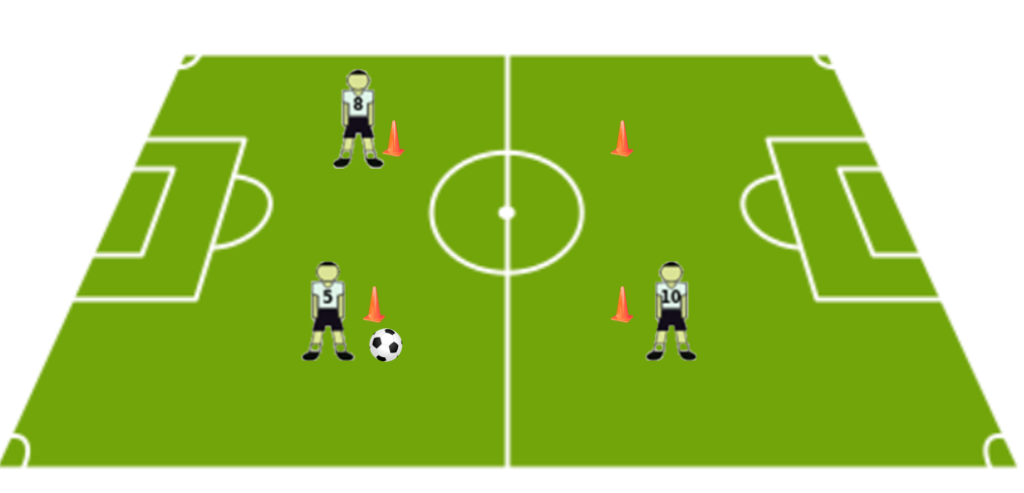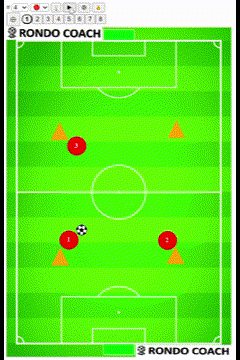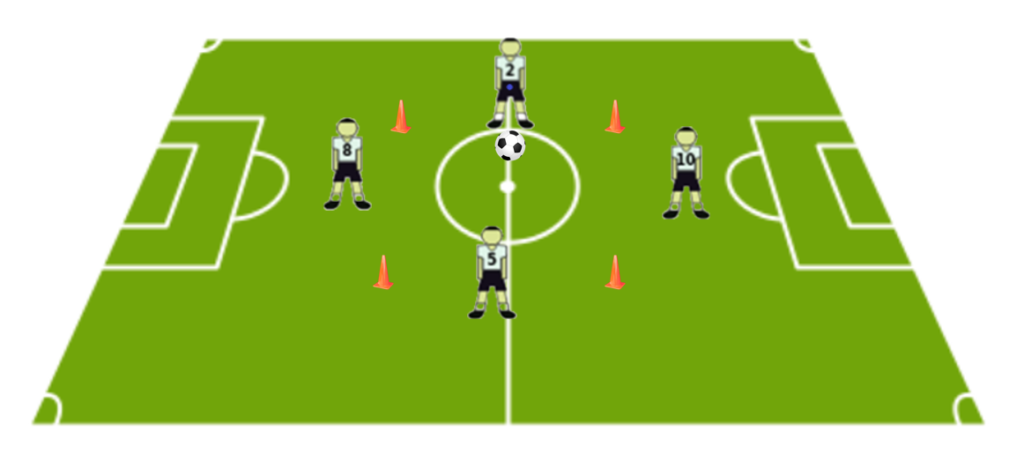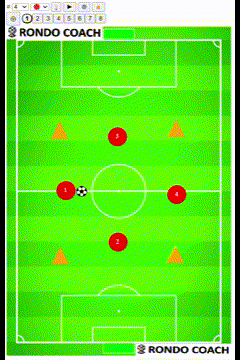No Opponent Soccer Rondo [Full Guide for Beginners]
Ok, you agree that tiki-taka is only possible with the rondos. You set up a nice dynamic 4v2 with only four cones. You place them close by, because the best teams practice in tight spaces and because that’s how far the 7-year-old players can pass. You feel like a genius, feeding two birds with one scone. You start the drill and… Ah, too challenging, let’s remove one defender and make it 4v1. Still can’t make more than 2 passes. Your mentor suggests doing no opponent soccer rondo. What? What kind of rondo is that?
No opponent soccer rondo 3v0

Setup
As the first rondo we will ever do, this one has 4 cones at 8-10 yards/meters away. That will be our standard setup and only the size of the sides will change as we see it be too hard or too easy for the players.
Game
We start with the ball with the player in the middle (player 1), choosing where to pass the ball. If 1 passes to 2, then 3 occupies the empty cone. Otherwise, 3 receives the ball and 2 occupies the empty cone. The upside is that the players will naturally move if they don’t get the ball. The downside is that the passer stands still, so we don’t get them to naturally learn “pass and go“.

Instructions
Step 1: Just follow the rules and see that the players are doing the right things within the rules.
Step 2: This is the first time we introduce “backfoot” as a concept. Some coaches call it “across your body”, but we prefer using one word, as it is something we will repeat hundreds of times each month for years. It’s the idea to receive the ball with the foot further away from the passer so that it is easier to face the passer, but also the third player when they are about to come to the free cone.
Step 3: The last lesson in this setup is the weight of the pass. Only a few players naturally pass in space, meaning where the player is running towards. Instead, almost everybody passes to feet, i.e. where the player is at the moment. As the third player is running toward the empty cone and we know where he would end up. This is an opportunity to challenge the players to pass in space and get the time and weight of the pass right so that it arrives at the same time as the player.
No opponent soccer rondo 4v0

Setup
Same cone setup as before. However, this time each player is between two cones. This is the first time they will really see the diamond that will become their natural playing shape. Make sure you tell them that they can move anywhere along the line between the two cones. You should also show them that the movement is sideways always facing the inside of the square.
Game
There are two games that you can play at this point. The first one is to set two 4v0 rondos side by side and challenge them to get to 30 passes. Whichever group gets to 30 passes first wins. You might need to add more limits, such as the fact that backpasses are not allowed. Otherwise, two players will come close to each other and just pass the ball until they win.
The second game is to make players go and touch a cone after they pass. This game is to counter the static passer from the 3v0 rondo and to eliminate the issue from the previous game by passing back. Feel free to combine the two games together and have fun. At this point, the players should be more proficient in passing, so challenge them to try a one-touch pass.

Instructions
This is the first time the players will do decision-making in terms of the actual position to pass the ball to. As a result, they will not actually pass the ball to the backfoot, not pay attention to the weight of the pass and not care about who they are passing to. The last is ok, but the first two should be addressed even at this point. Remind them that in order to have a complete pass, both the passer and the receiver need to try their best and work together.
RONDOS
No Opponents Rondo
Introduction to rondos with 3v0 and 4v0. Coaching passing, receiving, and the concept of “backfoot”.
First opponent
Introduce an opponent in the rondo. Create the need to move off the ball and think of passing lanes.
Increase intensity
Limit one passing option, and improve decision-making. Put pass-and-go into practice. Introduce a transition rondo to 5v3.
Increase complexity
Introduce team pressing of two players. Coach the central midfielder for the first time.
Pro Rondo
The rondo that pros play. Teaching to split the opponents with the right weight of the pass.
Positional play
All variations of the complex rondos before transitioning into positional play and game scenarios.

